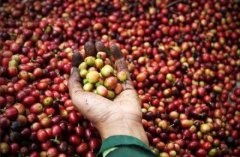The characteristics of Venezuelan coffee
Venezuela introduced coffee trees from Martinique as early as 1730, but coffee production was almost abandoned at the height of the oil industry. Recently, coffee plantations have begun to recover, with the original planting of Tipica and bourbon coffee trees and new plantations laying the foundation for coffee exports.

Coffee producing areas in Venezuela:
The best coffee producing area in Venezuela is the southwestern state of Tachira. But the name Tazira has been indiscriminately used for coffee beans across the country.
The best coffee names in Venezuela are: Montebello in San Cristobal (SanCristobaldeTachira) in Tazira, Miramar in Rubio (RubiodeTachira) in Tazira, Granija in Timothe (TimotedeMerida) in Merida, and AlaGranjia in SantaAnnadeTachira in Tazira. Other premium brands include Maracaibos (the name of the coffee export port), Merida, Trujillo (Trujillo), SantaFilomena and Cucuta.
One of the many plantations in Merida at the foot of the Andes belongs to the Pablo and Pulido families, an ancient farm that has been allowed to downsize. Since taking over the farm in the early 1980s, the Pulido family has grown new trees to expand the farm while harvesting coffee from existing bourbon trees.
The Caracas Zhouyuan area, once famous for its coffee, has resumed production. In addition, the Jean and Andries AndresBoulton plantations in the Turgua region also grow Tippica coffee trees.
The characteristics of Venezuelan coffee:
Venezuelan coffee tastes different from other coffee in Latin America. It is delicious, light and less sour than traditional coffee, which makes it not only blended but also distinctive.
Flavor: rich and delicious fruit flavor
Suggested baking method: medium to deep baking, multiple uses
★★: good
The market for Venezuelan coffee:
Currently, most Venezuelan coffee is exported to Russia and Colombia, where it is repackaged. Many small newly rebuilt plantations have also begun to export coffee on their own. The coffee industry is not very prominent among the many industries in the country.
Important Notice :
前街咖啡 FrontStreet Coffee has moved to new addredd:
FrontStreet Coffee Address: 315,Donghua East Road,GuangZhou
Tel:020 38364473
- Prev

Mexican coffee Mexican coffee specialties and markets
Mexico is the fourth largest coffee producer in the world. Most of its coffee is produced by nearly 100,000 small farmers, and the large estates that once dominated the coffee industry are few and far between. Mexico's coffee growing region: Mexico's best coffee growing region is Chiapas in the south of the country, where coffee varieties include Tapanchula and Hui
- Next

Tahiti coffee the characteristics of Tahiti coffee
It would be a privilege to have Tahiti coffee, because it is extremely rare. Tahiti Coffee Origin: Tahiti Coffee is a kind of Arabica Coffee (TahitiArabica). Tahiti is the largest island in the Social Islands (SocietyIslands). Tahiti coffee features: Tahiti coffee.
Related
- Detailed explanation of Jadeite planting Land in Panamanian Jadeite Manor introduction to the grading system of Jadeite competitive bidding, Red bid, Green bid and Rose Summer
- Story of Coffee planting in Brenka region of Costa Rica Stonehenge Manor anaerobic heavy honey treatment of flavor mouth
- What's on the barrel of Blue Mountain Coffee beans?
- Can American coffee also pull flowers? How to use hot American style to pull out a good-looking pattern?
- Can you make a cold extract with coffee beans? What is the right proportion for cold-extracted coffee formula?
- Indonesian PWN Gold Mandrine Coffee Origin Features Flavor How to Chong? Mandolin coffee is American.
- A brief introduction to the flavor characteristics of Brazilian yellow bourbon coffee beans
- What is the effect of different water quality on the flavor of cold-extracted coffee? What kind of water is best for brewing coffee?
- Why do you think of Rose Summer whenever you mention Panamanian coffee?
- Introduction to the characteristics of authentic blue mountain coffee bean producing areas? What is the CIB Coffee Authority in Jamaica?

